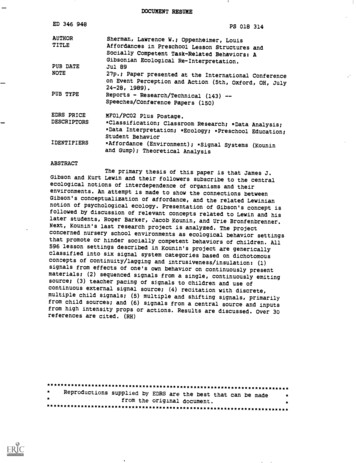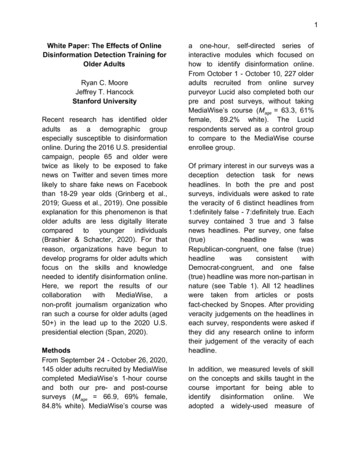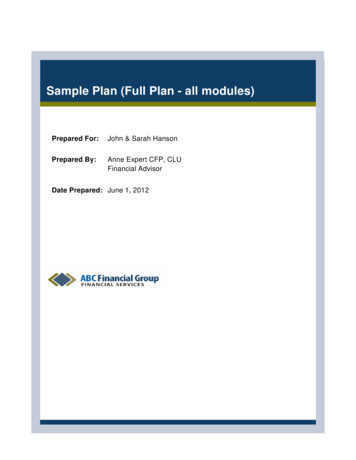
Transcription
DOCUMENT RESUMEED 346 948AUTHORTITLEPUB DATENOTEPUB TYPEEDRS PRICEDESCRIPTORSIDENTIFIERSPS 018 314Sherman, LaWrence W.; Oppenheimer, LouisAffordances in Preschool Lesson Structures andSocially Competent Task-Related Behaviors: AGibsonian Ecological Re-Interpretation.Jul 8927p.; Paper presented at the International Conferenceon Event Perception and Action (5th, Oxford, OH, July24-28, 1989).Reports - Research/Technical (143) -Speeches/Conference Papers (150)mFo1/Pco2 Plus Postage.*Classification; Classroom Research; *Data Analysis;*Data Interpretation; *Ecology; *Preschool Education;Student Behavior*Affordance (Environment); *Signal Systems (Kouninand Gump); Theoretical AnalysisABSTRACTThe primary thesis of this paper is that James J.Gibson and Kurt Lewin and their followers subscribe to the centralecological notions of interdependence of organisms and theirenvironments. An attempt is made to show the connections betweenGibson's conceptualization of affordance, and the related Lewiniannotion of psychological ecology. Presentation of Gibson's concept isfollowed by discussion of relevant concepts related to Lewin and hislater students, Roger Barker, Jacob Kounin, and Urie Bronfenbrenner.Next, Kounin's last research project is analyzed. The projectconcerned nursery school environments as ecological behavior settingsthat promote or hinder socially competent behaviors of children. All596 lesson settings described in Kounin's project are genericallyclassified into six signal system categories based on dichotomousconcepts of continuity/lagging and intrusiveness/insulation: (1)signals from effects of one's own behavior on continuously presentmaterials; (2) sequenced signals from a single, continuously emitingsource; (3) teacher pacing of signals to children and use ofcontinuous external signal source; (4) recitation with discrete,multiple child signals; (5) multiple and shifting signals, primarilyfrom child sources; and (6) signals from a central source and inputsfrom high intensity props or actions. Results are discussed. Over 30references are cited. *************************Reproductions supplied by EDRS are the best that can be madefrom the original ***************s**************
U.S. DEPARTMENT OF EDUCATIONOffice of Ed00811100a1lik.1011 and ImprovementEDUCATIONAL RESOURCES INFORMATIONCENTER (ERIC'vsaXThis document haft been reproduced asreceived from the person or organizationoriginating itMinor changes have been made to improvereproduction qualityPoints& yiev/ or opinions slated in thls dOCument do nO1 neCeltaargy /*present officialOERI position co policyt4Title: Affordances in preschool lesson structures and socially competenttask-related behaviors: A Gibsonian ecological re-interpretation. A paperpresentation to the Fifth International Conference on Event Perception andAction, Miami University, Oxford, Ohio, July 24-28, 1989.vjtiAuthors: Lawrence W. Sherman, Miami University, Oxford, Ohio, USA, BITNET:LS8CEDPF @MIAMIU and Louis Oppenheimer, Univeristy of Amsterdam, TheNetherlands, BITNET: OPPENHEIMER Q SARA.NL.1)During the late 1960's and throughout the 1970's severalABSTRACT.oral presentations and paper publications were the result of a researchgrant (MH-15472) from the National Institute of Mental Health, Jacob S.andThe project consisted of a naturalisticKounin, Senior Researcher.exploratory ecological analysis, over a two-year period of time, of 87preschoolers' (between 29 and 60 months of age) and 36 student teachers'Task-related behaviors of both the children and thevideo taped behaviors.teachers were examined in 596 different lessons, each teacher directingIn addition, 37 children's behaviors, one at alessons.approximately 18time, were video-taped throughout a typical 3-hour nursery school day whereA comprehensive summary oftheir undirected free-play time was monitored.several analyses which were derived from this project is contained indata were analyzed thethe time theseAt(1979).Kounin & Shermanresearchers associated with this project were not aware of James J.theoriesReed & Jones, 1982)Gibson, 1983; Reed, 1988;Gibson's (1979;For the most part, the results of these studiesconcerning "affordances."were explained from an "ecological" perspective based on the earlier workKounin, Paul Gump and Roger Barker (1968), all originallyof Jacob S.influenceed by Kurt Lewin/(Kounin and Barker were students of Lewin duringthe late 1930's). An ecological model assumes interaction between organismssetting," sometimesThe concept of "behaviorand their environment.explainthesedata(See Kounin &Barker,wasusedtoattributed to RogerSherman, 1979). Early in the 1980's the present researchers became aware ofGibson's theories concerning "affordances" and began to re-examine how thisconcept provided an alternative explanation for the earlier studies. /The1974;present paper suggests that these earlier studies (Kounin & Gump,.IASherman, 1975;Kounin & Sherman, 1979) may be explained using Gibson's'SP concept of affordances, especially as this concept relates to socially1989)inpreschool educational(Oppenheimer,competent interactionslesson settings were generically classified into sixenvironments.AllEach is shown to afford more or less tasksignal system categories.related behaviors. Appropriate and inappropriate standing behavior patterns051) of the children are used as a dependent variable predicted by the signalisItsystem categories of the lessons irrespective of the teachers.raj believed that these empirical data, explained from a Gibsonian point ofview, might support an extension of the affordance concept to the domain ofAlso included is a discussion of the some4::) socially competent interaction.historical relationships between Gibsonian Affordance theory and theondynamic psychological theories of Kurt Lewin and his later students.0"PERMISSION TO REPRODUCE THISMATERIAL HAS BEEN GRANTED BYp64\P\f12REST COPYA V JIk.\ 4\N CA \A.\TO THE EDUCATIONAL RESOURCESINFORMATION CENTER (ERIC)."
INTRODUCTIONItisnotuncommon for different scholars to arrive at similarconclusions independant of each other. This is sometimes especially true ofscholars who are contemporaries of each other.It is suggested that tworeasons for this lack of awareness might be 1) theslow pace at whichresearch is published, and 2) the vast differencesproblems andissues upon which each researcher focuses. This is betweenone of the primarytheses of this paper.James Gibson's early concernproblems ofperception probably may not have directed him toward group fordynamicsissueswhich were of pr imary concern to Kurt Lewinduring the 1940's.WhileGibson's early research was contemporary with Kurt Lewin's,andcertainlyhe was aware of Lewin's earlier thoughts regarding"life-space"or"dynamicpsychology," he does not seem particularly aware of Lewin'stwo principalstudents during the late 1930's and early 1940's,RogerBarkerand Jacob S.Kounin,both of whom were strongly influenced by Lewin aswell as quiteinfluential to each othe: and continued to advanceLewin'snotion ofpsychology ecology. Bronfenbrenner (1977;1979) is another example of ascholar strongly influenced by Lewin's concept, psychologicalecology. Thenotion of "interdependence"is central to any definition of ecology,thescience of studying the interactions of organisms and theirenvironments.One cannot come to a complete understanding ofthenatureofsocialactionswithout also considering the contexts(life-space)withinwhichtheyhappen.It is the primary thesis of thispaper that both Gibson and Lewin andthe various followers of each subscribeto the centralof interdependence of organisims and their environments.ecological notionsWe believe itmight be better to view these different approachesas complimenting ratherthan opposing each other. Therefore, an earlyattemptwill be made to showthe connections between Gibson'sconceptualization of "Affordance," and therelated Lewinian notion of "psychological ecology."Gibson's concept willbe presented, followed by some relevantconcepts related to Lewin and hislater students, RogerBarker and JacobKounin,aswell asUrieBronfenbrenner.This will be followed by a descriptionandre-analysisofKounin's last research project which examined nurseryschoolenvironmentsas ecological behavior settings which eitherpromote or hinder sociallycompetiteut behviors of children.THE THEORISTS.Gibson and Affordances. Eleanor J. Gibson,wife of the late JamesGibson, has described her husbands conceptof "affordance" within thecontext of a "Renascence of Functionalism" (Gibson, 1983,p.55; also, seeGibson,1988), stating that "It is a matter of commonagreementamongscientists that not many ideas are new." Shegoes on to define affordance(Gibson, 1979):The affordances of the environment are what it offers the animal,what it provides or furnishes, either forgood or ill.The verb2Li
to afford is found in the dictionary, but the noun affordance isnot.Ihave made it up.I mean by it something that refers toboth the environment and the animal in a way thatno existingterm does. It implies the complementarity of the animal and theenvironment. (p. 127)An important fact about the affordances of the environment isthat they are in a sense objective, real, and physical, unlikevalues and meanings, which are often supposed to be subjective,phenomenal, and mental.But, actually, an affordance is neitheran objective property nor a subjective property; or it is both ifyou like. An affordance cuts across the dichotomy of subjec iveobjective and helps us to understand its inadequacy.Itisequally a fact of the environment and a fact of behavior.It isboth physical and psychical, yet neither. An affordance pointsboth ways, to the environment and to the observer. (p. 129)Additional definitions and discussions19 2:are also included in Reed& Jones,Not only objects but also substances,places,events, otheranimals,and artifactshave affordances.Iassume thataffordances are not simply phenomenal qualities of subjectiveexperience(tertiaryqualities,dynamic andphysiognomicproperties, etc.).Ialso assume that they are not simply thephysical properties of things as now conceived by physicalscience.Instead,they are ecological,in the sense that they.are properties of the environment relative to an animal. Theseassumptions are novel, and need to be discussed. (p. 404).The meaning or value of a thing consists of what it affords. Notetheimplications of this proposed definition.What a thingaffords a particular observer (or species of observer) pointstothe organism, the subject. The shape and size and composition andregidity of a thing, however, point to itsphysical existence,the object.But these determine what it affords the observer.The affordance points both ways.What a thing is and whatitmeans are not separate, the former being physical and the lattermental, as we are accustomed to believe.The behavior of the animal has to be controled by the affordance(forhim)of thesubstance, object,or place.And thisaffordance has to be perceived by the animal if his behavior istobecontroled.True,the affordances of substances andsurfaces differ for different animals.The ant, the bird, andthe primate live in different "niches" as the ecologist puts it,but the reciprocity of the animal and its environment is thesamefor all. (Reed & Jones, 1982, p. 408)It should be emphasized that behavior (animalor human) and perceptionare both involved in the above definitions. Behaviorswith the affordances of the environment and this depends are in accordanceon the perceptions3(.4
of these environments. As psychologists, we must be concerned with what onecan do as well as with what one perceives. Proper action implies perception57)of the affordances offered by an environment. Eleanor Gibson (1983, p.forofthisconcept(Affordance)goes on to describe the importancedevelopmental psychologists stating:I need to find out what the environment offers in the way ofwhat the appropriateaffordances -- how to describe them,behaviors are -- and also whether and where they are perceived asaffordances.As there are appropriate behaviors, I ask in myexperiements on perception whether different affordances areTo what extent mustdifferentiated by appropriate behaviors.Andyoung creatures (human or otherwise) learn to perceive them?ifthey must learn,howisit done?.affordances are notThey are there toinvented or read into events by the perceiver.be perceived. (Gibson, 1983, p. 57)TheAffordances, we suggest, are at least partially learned.learning is primarily perceptual - differentiation of informativearrays, both modality-wise and within structure of a given arrayand detection of supramodal information over modalities. Inisadditiontherelearning throughtheobservationofconsequences of one's exploratory activity.Maturation of othersubsystgems (e.g.,action systems),as suggested in a systemsanalysis,is anotherfactor in development of perception ofaffordances. (Gibson & Schmuckler, 1989, p. 23)In detailing the historical context of Affordance Theory, James Gibsonacknowledges earlier theorists and related concepts including Lewin's term,"Valance" (Aufforderungscharakter), and Koffka's (1935) concept of "demandcharacter."His major sources for these concepts (valence, demandcharacter) are somewhat ancient and do not acknowledge later developmentswithin these theoretical schools: eg.,in refering to demand-character, hereferes to Koffka's Principles of Gestalt Psychology(1935),and whendiscussing Lewin's term,"valance," he refers to Adams(1931) and Brown(1929).The only relatively modern reference toLewin is Marrow's (1969)biography.Because ofthis lack ofreference to more contemporaryextensions of especially Lewinian dynamic theory, Gibson's(in Reed &Jones,1982, p. 409) discussion of differences between affordance theoryand Lewin's "life-space" theory may be somewhat wrongheaded. Gibson doesacknowledge some confusion with regard to the meaning of these t
later students, Roger Barker, Jacob Kounin, and Urie Bronfenbrenner. Next, Kounin's last research project is analyzed. The project. concerned nursery school environments. as ecological behavior settings that promote or hinder socially. competent behaviors of children. All. 596 lesson settings described. in Kounin's project are generically











